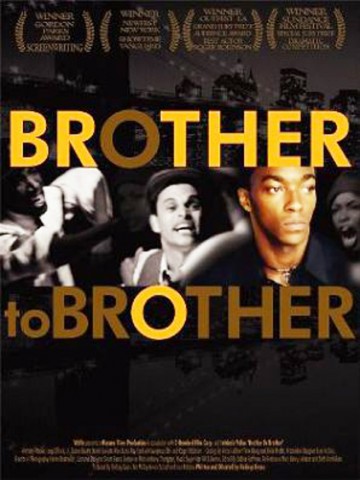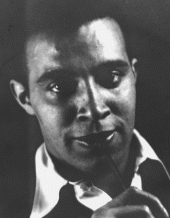 Brother to Brother
Brother to Brother
Written and Directed by Rodney Evans
Released January 17, 2004
Drama
94 min. • Find on imdb
Review by Stephen O. Murray
Film editor Rodney Evans wrote, produced, and directed Brother to Brother, a portrait of the artist as a young gay black man yearning for love and for connection to a gay black heritage.
Perry Williams [Anthony Mackie] is a student at Columbia and a budding painter. In the recent past, in Brooklyn, his father walked in and found him with another young black male in a compromising position and threw him out.
Family rejection is exacerbated by the freely expressed homophobia of the other black men in a black studies class Perry is taking (and playing James Baldwin to their Eldridge Cleaver-channeling thugs). The only classmate who is at all supportive is its one white male, Jim [Alex Burns]. Perry hopes that Jim will be his “special friend” and harbor from the storms battering him. Perry beds Jim and makes no allowances for Jim’s inexperience, storming off in a huff at an attempt by Jim to express appreciation.
Perry also rejects the interest in his work by a white gallery owner who sees some of Perry’s paintings in a group show. Perry’s hostility is directed at white men. He is unsubtly derogated and physically assaulted by straight black men (although he has one longtime protector who is a straight black man). As is often the case for young gay men, Perry does not have any father figure to link him to any gay tradition. Transmission of black gay culture/heritage is even less smooth than transmission of white gay culture. Perry has read Baldwin and is just discovering the writers of the Harlem Renaissance.

He has read “Smoke, Lilies, and Jade,” the scandalous (at the time) homoerotic story in the one and only issue of Fire!!, and realizes that an elderly man sleeping in a homeless shelter where Perry works is its author, Richard Bruce Nugent (portrayed by Roger Robinson). Although not conventionally successful, the elderly poet/painter still has quite a bit of joie de vivre and manages to inspire Perry, particularly when Perry is at his lowest point, moping in his room after being bashed. (Although I detect influences of Il Postino and Zorba, the Greek, this is the scene that makes the movie. It also leads to some interesting paintings…)
There is nothing within the movie to establish when its present-day is. I was moored by the knowledge that Nugent died in 1987. Having read quite a bit of Harlem Renaissance writing, I knew who the characters in Bruce’s flashbacks were and that what was shown fits with the literature of and about the Harlem Renaissance. Those with whom I saw the movie who lacked that familiarity, found the flashbacks confusing and thought the movie was set in this millennium.
Perry’s discovery of the forgotten survivor of the Harlem Renaissance is dramatically satisfying but could not have happened, because Nugent had already been rediscovered and interviewed in the early 1980s by Bruce Garber, Richard Lewis, and others. “Smoke, Lilies, and Jade” and Eric Garber’s article on the centrality of gay people to the Harlem Renaissance were reprinted in the 1983 anthology Black Men, White Men, and there was a chapter about Nugent in the successor 1986 anthology In the Life.
(It was also reprinted in The Portable Harlem Renaissance Reader (1994). Before the film was made, Nugent was quoted extensively in When Harlem Was in Vogue (1989), and portrayed in Steven Corbin’s No Easy Place To Be (1989) and Isaac Julien’s Looking for Langston (also 1989), as well as in Watson’s book. In 2002, a collection of Nugent’s writings was published, Gay Rebel of the Harlem Renaissance, edited with a substantial introduction by Thomas H. Wirth.)
 The relationship between the forgotten aged artist and the struggling young is more dramatic than the rediscovery of the black gay pioneer by white gay historians. The large and mostly black gay audience with whom I saw Brother to Brother were enthusiastic about the movie and its reclamation of a heritage.
The relationship between the forgotten aged artist and the struggling young is more dramatic than the rediscovery of the black gay pioneer by white gay historians. The large and mostly black gay audience with whom I saw Brother to Brother were enthusiastic about the movie and its reclamation of a heritage.
Although the characterizations of the Harlem Renaissance figures were sketchy, Ray Ford as Wallace Thurman and Duane Boutte as the young Bruce Nugent are compelling. So are the actors of the film’s present day. (I’ve forgotten the name of the character who plays Perry’s friend and protector, so can’t check IMDB to link his name. Whatever it is, he is superb.) Roger Robinson has the best role and plays it well. Anthony Mackie has the much tougher role of avoiding seeing himself as a victim or coming across as petulant. Being the witness to the Indomitable Human Spirit and the Our Lost Heritage is less flashy than incarnating them, but I think Mackie does very well.
The trailer can be seen via YouTube.
©2004, 2016, Stephen O. Murray
Originally posted on Epinions 27 June 2004

